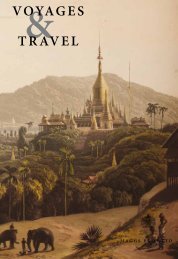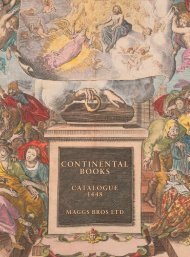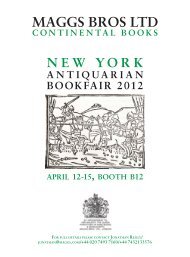A HAIRLESS HORSE, A CRAZY DIAMOND, A GAY TRAITOR ...
A HAIRLESS HORSE, A CRAZY DIAMOND, A GAY TRAITOR ...
A HAIRLESS HORSE, A CRAZY DIAMOND, A GAY TRAITOR ...
Create successful ePaper yourself
Turn your PDF publications into a flip-book with our unique Google optimized e-Paper software.
single pulp paperbacks priced individually from a few pounds to large collections of wild Oriental<br />
antiques, Pop art, and so on, for much more money. He was a Mickey Mouse type, seemingly in two<br />
places at the same time, for he travelled constantly and bought from everyone – the bouquinistes<br />
on the banks of the Seine, a laid back A-frame dwelling hippy dealer of California, a bohemian<br />
Parisian poster dealer in a converted garage, an auteur photo galleriste, the retro soft porn dealers<br />
of Lyon, the psychedelic specialist of Greenwich Village, a hip bookshop in Notting Hill, Timothy<br />
Leary’s archivist, a Beat books vendor in an Islington basement and the big auction rooms of the<br />
Western World. In the latter, he arguably drove the price way up for ‘funky’ stuff by the Marquis de<br />
Sade, Hans Bellmer, Arthur Rimbaud, Charles Baudelaire, and others. He even, from time to time,<br />
bought books at an old bookshop in Mayfair called Maggs Bros. He also began to get to the source<br />
of the stuff from the sometimes ancient and venerable old longhaired hippies and Lower East Side<br />
punkers. He was at various times part of a number of scenes around the Stones, Warhol, Johnny<br />
Thunders, Max’s, The Lower East Side of Basquiat and Haring, etc.<br />
Most importantly, perhaps, he bought massively off Ebay at the very moment that the Englishspeaking<br />
world was emptying its garages and attics onto the internet. Then there was the rare book<br />
portion of the internet that he bought hugely from; he had people dedicated just to following up<br />
his want matches on ABE, I think. So, the shape and direction would probably have been very<br />
different if that lift had been summoned from below rather than from above. He was, of course, not<br />
alone in this great passion for collecting the counterculture, there are other great private collectors<br />
such as Philip Aarons and Richard Prince but his buying in overlapping areas surely affected their<br />
book hunts, their goals, the availability of material and the way that it was presented and, indeed,<br />
priced in dealers’ catalogues. He was a very superstitious man, and a dead dog, like the albatross to<br />
the maritime explorers of old, or a crow to the Norseman, could have been a very bad omen for him<br />
indeed.<br />
Aside from these ‘butterfly’ sort of effects, how does a book become collectable, a good book to<br />
collect? I’ll model very crudely how it happened for some books in the twentieth century, in the<br />
hope that this will illuminate the collecting of counterculture. On occasion, books that became<br />
collectable were tested or ‘made’ first by the primary market, they had saleability, they were<br />
popular. People bought the book, it became scarce or, rather, it went out of print, and they started<br />
to look in the second-hand market for other copies. This was the case with Ian Fleming’s Bond<br />
series of novels, and also TE Lawrence. You might equally ask how a theory becomes a truth in<br />
science; ideally, there is a theory that is tested through experimentation and observation. So, for<br />
example, Einstein’s theory that light was deflected by the gravitational field of large planetary<br />
bodies was proved by Eddington’s observations and measurements of a solar eclipse. You might call<br />
this the inner truth of how a book becomes collectable and in parallel how a hypothesis is proved.<br />
Then there is the external bit, it is not enough to have a theory proved in the lab or the field. It<br />
has to be disseminated and tested through peer-reviewed journals, conferences, popular science<br />
books, lobbying and, of course, it has to be given funding to become ‘true’. Similarly, enterprising<br />
rare book dealers, auctioneers and some collectors catalogue books and produce books about books<br />
to bring out their nuances, create a sense of connoisseurship and thereby make them more<br />
desirable and, in the process, create bigger markets. Film adaptations are made, Fleming and Bond<br />
again, further stimulating the market and increasing the pull, the shelf appeal, and adding noughts<br />
to the price. Examples of very important collector catalogues that drove markets include Printing<br />
and The Mind of Man and Martin Parr and Gerry Badger’s two volume history of photobooks. These<br />
became shopping lists for collectors. You could say the same for learned journals and magazines<br />
such as Nature and New Scientist which drove funding to exploit scientific discoveries.<br />
You may well also have a stratum of wealthy collectors who all hit the demographic bend at the<br />
same time and create an even richer market for the books already at ‘critical mass’, exploding them<br />
into the realms of super collectability. You might call this the ‘external’ way that books become<br />
collectable and truths become true, i.e. both are partly determined by society and not the quality of<br />
the text or the conclusions of an experiment. Most importantly, a good book can be determined by<br />
how much money and effort is put into marketing it. The amazing publicity machine used by the<br />
big auction houses is one example of money and marketing. In a rather too perfect example of this<br />
parallel between science and book collecting, a wealthy vice president of J.P. Morgan called Gordon<br />
Wasson believed that the ancient drug Soma of the Sanskrit Rg Veda, was in fact the red and white<br />
fly agaric mushroom of European fairytales. He kept the idea in vogue by printing his books in fine<br />
bindings, beautifully laid out with great typography, in limited editions and on good paper printed<br />
at the Stamperia Valdonega in Verona.<br />
In 1973, a Russian scholar noted this ‘bling effect’ in a letter to the late John Brough, the<br />
2






